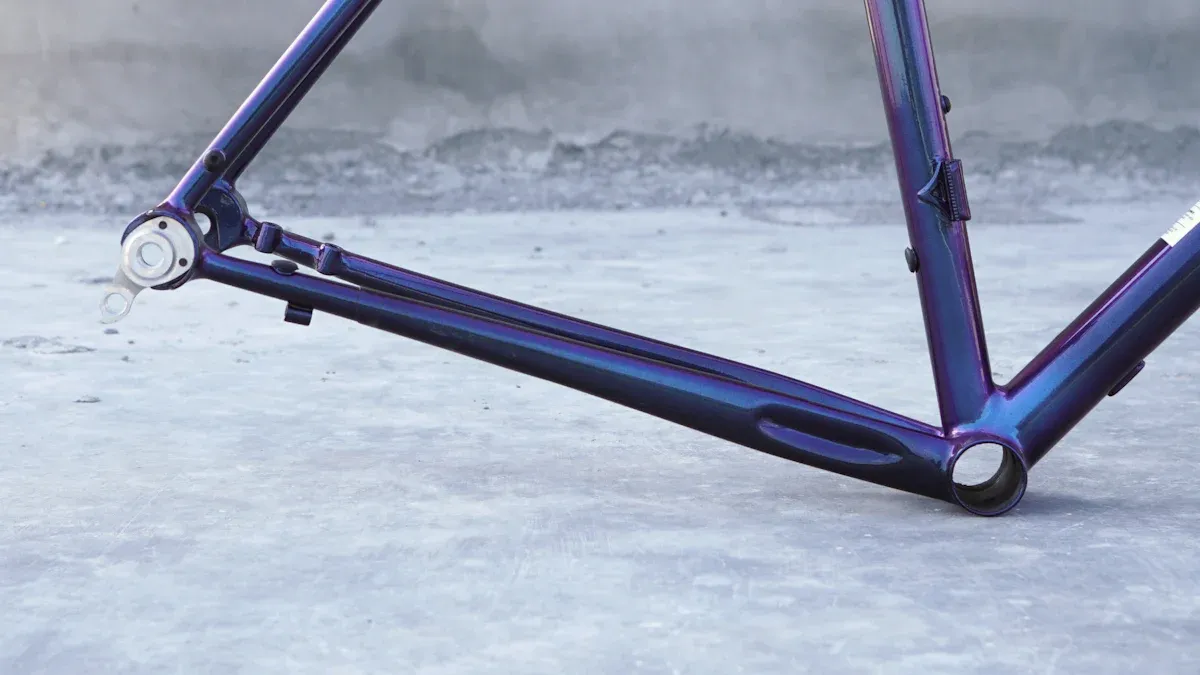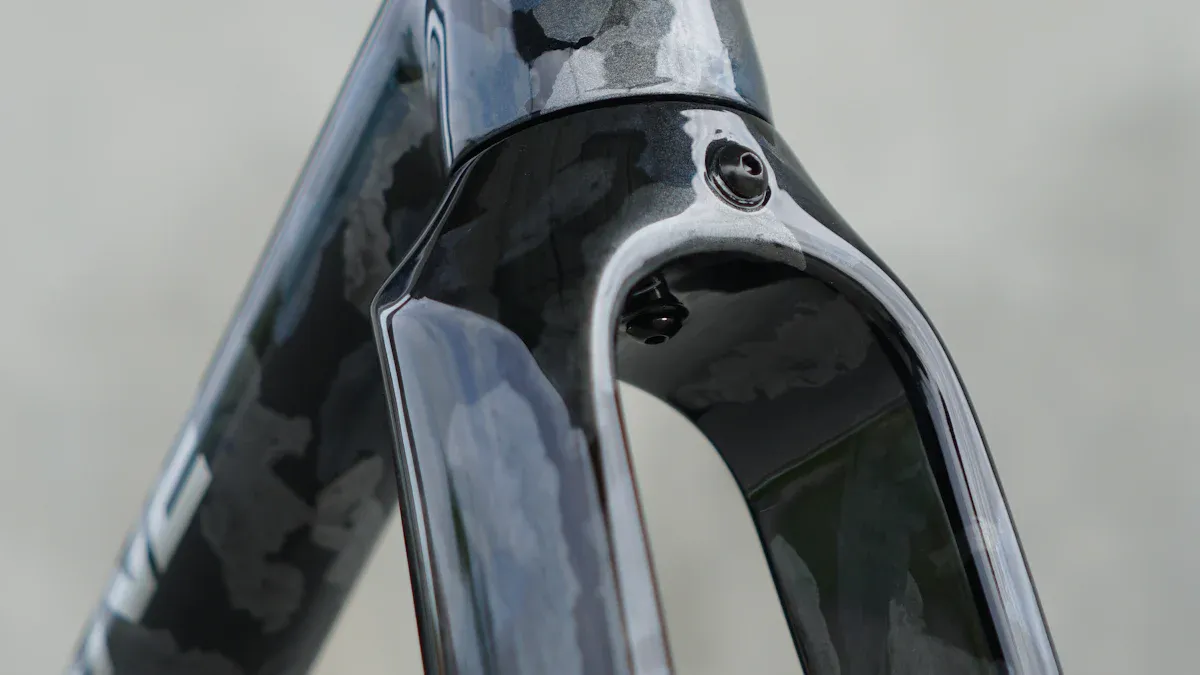
Choosing the right road bike frame materials is very important. It can change how you feel while cycling. Each material has its own good and bad points. These points can affect how well you ride and how comfortable you are. For example, aluminum is light but can shake a lot. Steel is great at soaking up bumps, making it perfect for long rides. Titanium gives a smooth ride by reducing vibrations. Carbon fiber is made for speed but can feel hard sometimes. Knowing these differences in road bike frame materials helps you make smart choices for your cycling needs.
Key Takeaways
Pick light materials like carbon fiber for easier handling and faster speeds.
Think about how long it will last; steel and titanium frames last longer than aluminum and carbon fiber.
Focus on comfort; steel and titanium soak up road bumps well for a smoother ride.
Check your budget; aluminum frames give a good mix of price and performance.
Know the trade-offs; each material has special pros and cons that change your cycling experience.
Steel Frame Advantages

Steel bike frames have many good points. This makes them a favorite for cyclists. First, their durability is impressive. Steel frames can handle daily use well. They last longer than other materials. This means they can take more stress before wearing out. You can count on a steel frame to last many years. This makes it a smart choice.
Steel bike frames are known for being customizable. This helps improve ride quality and performance. They are durable and last longer than carbon. This allows for smaller fork blades that flex and absorb shocks. Also, steel frames are great for handling and reliability. They work well in different riding conditions.
Another big plus is comfort. Steel frames are good at soaking up road vibrations. This gives you a smoother ride. Many riders feel relaxed and comfortable, especially on long trips. The balance between road feel and comfort lets you sense the road without too much discomfort from bumps.
When you look at the weight of steel frames, they are usually heavier. Here’s a quick look at the average weights of different bike frame materials:
Material | Average Weight (pounds) | Average Weight (kg) |
|---|---|---|
Steel | 1.36 to 2.04 | |
High-end Steel | 3.3 to 3.5 | 1.5 to 1.6 |
Carbon | Slightly lighter | N/A |
Even though steel frames might not be the lightest, their strength and comfort often make up for this for many cyclists.
Steel Disadvantages
Even with their many benefits, steel bike frames have some downsides. One big issue is their weight. Compared to aluminum, carbon fiber, and titanium frames, steel frames can feel heavy. This can slow you down, especially when racing or climbing hills.
Another problem is corrosion. Steel can rust if not taken care of. Rust can weaken steel bike frames, leading to safety risks. Regular maintenance, like cleaning and using protective coatings, is important to prevent rust. Areas that can rust include the chain, spokes, bolts, and frame joints. This can affect how well the bike works.
Finally, high-end steel bikes are not as easy to find as those made from other materials. This can limit your choices when looking for the right bike frame.
Aluminum Frame Advantages
Aluminum bike frames have many advantages that make them popular with cyclists. First, they are very lightweight. Aluminum is one of the lightest metals for bike frames. This helps you handle and perform better on the road. You will see that aluminum frames weigh less than steel frames, making them easier to control. Carbon fiber frames are about 30% lighter than aluminum frames, but aluminum still has a good mix of weight and strength.
Another big plus is corrosion resistance. Unlike steel, aluminum does not rust. When it is in the air, aluminum creates a protective layer. This layer keeps the metal safe from rust, so your bike frame stays strong over time. But be careful, as things like saltwater can damage this layer and cause rust in some spots.
Aluminum frames are also very stiff, which helps with power transfer. This means when you pedal, more of your energy moves the bike forward. You will feel a quick ride, especially when sprinting or climbing. The durability of aluminum frames makes them great for everyday cycling. They can handle regular use without much wear.
Here’s a quick look at the main advantages of aluminum bike frames:
Lightweight: Improves handling and performance.
Stiffness: Gives efficient power transfer for a quick ride.
Durability: Strong and resistant to rust.
Affordability: Usually cheaper than carbon fiber or titanium.
Versatility: Can be shaped for different bike designs.
Recyclability: Good for the environment because they can be recycled easily.
Aluminum Disadvantages
Even with their many advantages, aluminum bike frames have some disadvantages. One big problem is that they can send road vibrations straight to you. This can make long rides uncomfortable. You might find that aluminum frames feel rougher than steel or carbon fiber frames, which absorb vibrations better.
Another issue is that aluminum frames can wear out faster than steel frames. While steel can last a lifetime, aluminum usually lasts only 5 to 10 years. This shorter life can worry long-term cyclists. Also, aluminum frames need special tools for repairs, making them harder to fix than steel frames.
Here’s a summary of the most common disadvantages of aluminum bike frames:
Disadvantage | Description |
|---|---|
Harder to fix | Aluminum frames need special tools for repairs, making them tough to fix compared to steel frames. |
Not too comfortable | Aluminum frames send shocks and vibrations more than steel frames, leading to a less comfy ride. |
Aluminum frames don’t last long | Aluminum frames wear out faster than steel, usually lasting only 5-10 years, while steel frames can last a lifetime. |
Can’t change the hub spacing | The stiffness of aluminum stops changes to hub spacing, limiting wheel choices. |
More dangerous | Aluminum frames can break suddenly without warning, which is a safety risk, unlike steel frames that often show signs of wear before breaking. |
Carbon Fiber Frame Advantages

Carbon fiber bike frames have many advantages that make them a great choice for serious cyclists. First, their lightweight design helps with handling and speed. You will see that carbon fiber is much lighter than steel or aluminum. This lighter weight helps you climb hills and go faster.
Another big benefit is the superior strength and durability of carbon fiber. It has a strong-to-weight ratio, which means it can handle stress without being heavy. This quality lowers the chance of dents or bends, keeping your frame safe during tough rides.
Carbon fiber also gives enhanced ride comfort. The material absorbs road vibrations well, which means less tiredness on long rides. This is especially helpful for endurance events where comfort matters a lot.
Also, carbon fiber frames are great for aerodynamic efficiency. Makers can shape carbon fiber in many ways, which helps reduce drag. This aerodynamic benefit lets you go faster with less effort.
Here’s a quick overview of the main benefits of carbon fiber bike frames:
Benefit | Description |
|---|---|
Lightweight Design | Carbon fiber is much lighter than steel or aluminum, which helps with handling and speed. |
Superior Strength and Durability | Strong-to-weight ratio lets carbon fiber handle stress without adding weight, lowering the chance of dents or bends. |
Enhanced Ride Comfort | The material absorbs road vibrations, leading to less tiredness on long rides, perfect for endurance events. |
Aerodynamic Efficiency | Flexibility in design allows for better shapes, reducing drag and helping you go faster. |
Customizability and Innovation | Carbon fiber can be shaped in many ways, allowing for new ideas and designs for different cycling needs. |
Carbon Fiber Disadvantages
Even with their many advantages, carbon fiber bike frames have some disadvantages. One big worry is the risk of catastrophic failure. Unlike steel, which bends and shows wear, carbon fiber can break suddenly. This sudden break can be dangerous, especially for riders who push hard.
Another downside is the cost. Carbon fiber frames are usually more expensive than aluminum or steel. This higher price can be a problem for many cyclists, especially those with a budget.
Lastly, while carbon fiber frames are strong, they need careful handling. You should avoid hits that could harm the frame. Repairs can also be trickier than with metal frames, as they often need special tools and skills.
Titanium Frame Advantages
Titanium bike frames have many advantages that make them a great choice for many cyclists. First, titanium is known for its strength and lightweight properties. It is as strong as steel but much lighter. This means you can have a strong frame without the extra weight. This is helpful when climbing hills or going on long rides.
Another big benefit is the comfort that titanium frames give. Titanium naturally bends a little, which helps soak up small bumps and vibrations. This makes your ride smoother. You will enjoy how titanium frames keep control on rough paths without too much shaking.
Durability is another strong point for titanium. These frames do not rust or wear out easily. They can stay strong for many years. Unlike aluminum and carbon fiber, which can break down over time, a good titanium frame can last a lifetime with little care. Many cyclists find their titanium frames stay reliable even after many years of riding.
Here’s a quick overview of the main advantages of titanium bike frames:
Strength: Just as strong as steel, but lighter.
Lightweight: Makes climbing and long rides easier.
Comfort: Soaks up shocks and vibrations well.
Durability: Does not rust or wear out, lasting for decades.
Low Maintenance: Needs less care because it is strong.
Titanium Disadvantages
Even with their many advantages, titanium bike frames have some disadvantages. One big problem is the high cost. Titanium frames usually cost more than steel, aluminum, and carbon fiber frames. The hard work needed to make titanium frames adds to this higher price, which can be a problem for some cyclists.
Another issue is the difficulty in machining. Titanium is tough to work with, needing special tools and skills for making and fixing. This can limit your choices when looking for a frame or getting repairs.
Also, titanium frames may be less available than other materials. Not many companies make titanium frames, which can make it harder to find the right one for you.
Finally, while titanium has a good mix of stiffness and comfort, it can bend more than materials like carbon fiber. This bending can affect how well it performs in tough situations, especially during races.
Here’s a summary of the common disadvantages of titanium bike frames:
High Cost: Costs more to make and buy.
Difficulty in Machining: Needs special tools and skills.
Lower Availability: Fewer makers and limited frame choices.
Repair Challenges: Hard to fix if damaged.
Potential for Flex: Bends more than carbon fiber, affecting performance.
Choosing the right road bike frame materials is very important for your ride. Each material—steel, aluminum, carbon fiber, and titanium—has its own good and bad points. Think about things like weight, strength, and cost when you decide. Here are some key things to remember:
Weight: Light materials like carbon fiber help you ride better.
Durability: Steel and titanium last a long time, while aluminum is cheaper.
Comfort: Steel and titanium are great for comfort, soaking up bumps well.
Budget: Aluminum frames usually give the best mix of price and performance.
Look at your own cycling needs and likes to find the best bike materials for you.
FAQ
What is the best bike frame material for comfort?
Steel and titanium frames are the most comfortable. They soak up road bumps well, giving you a smoother ride. If comfort matters most, think about these materials for long rides.
How do carbon fiber frames compare in performance?
Carbon fiber frames are great for performance because they are light and stiff. They help transfer power efficiently, making them perfect for racing and fast rides.
Are aluminum frames a good choice for beginners?
Yes, aluminum frames are excellent for beginners. They are light, strong, and affordable. You can get good performance without spending too much money.
How long do different bike frames last?
Steel frames can last a lifetime if cared for properly. Aluminum frames usually last 5 to 10 years. Titanium frames also last many years, while carbon fiber frames might need replacing after serious damage.
What should I consider when choosing a bike frame material?
Think about weight, strength, comfort, and price. Each material has its pros and cons. Consider your riding style and likes to make the best choice for you.
See Also
Comparing Enduro Bike Frame Materials For Durability And Strength
Evaluating Steel Mountain Bike Frames: Pros And Cons Explained
Understanding Track Bike Frame Materials And Their Importance
A Buyer’s Guide To Carbon, Aluminum, And Steel Bike Frames
Analyzing Aluminum Bike Frames: Durability Benefits And Drawbacks
